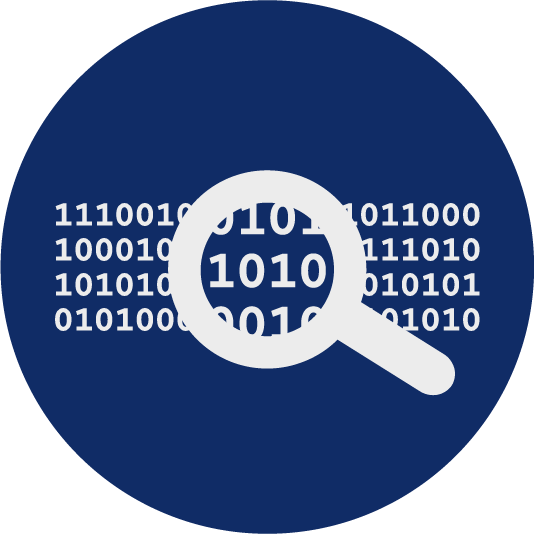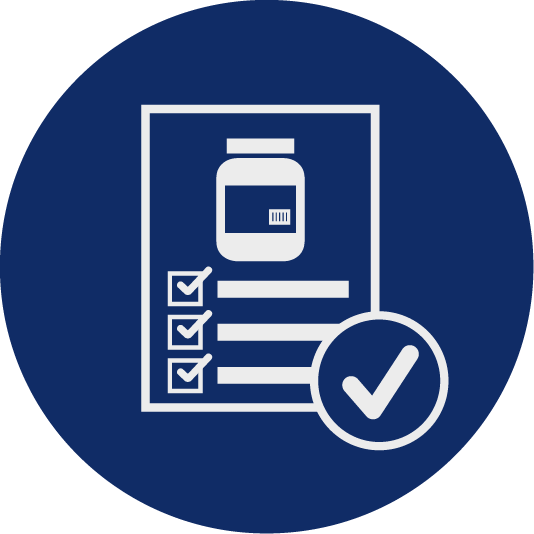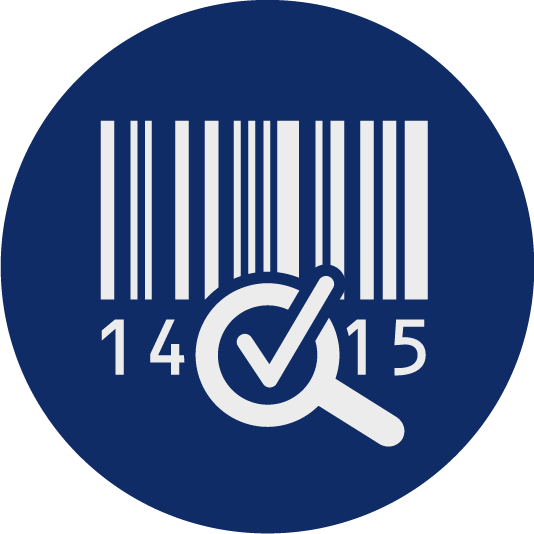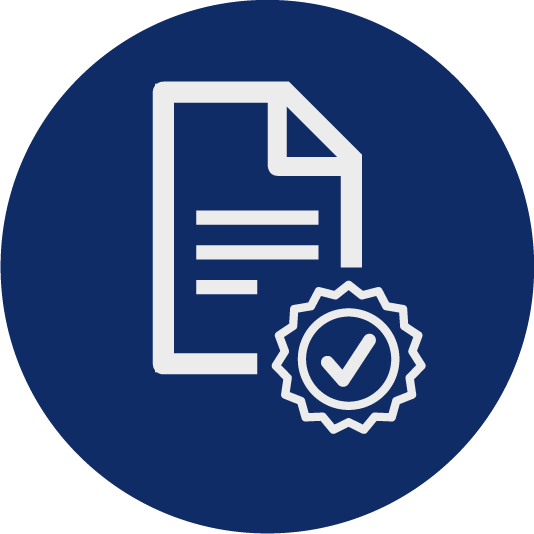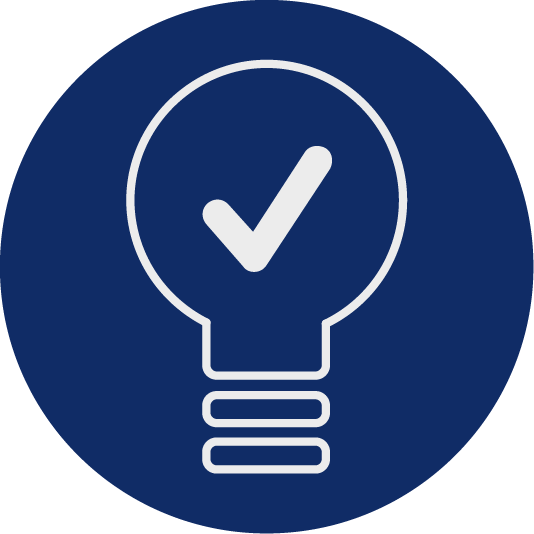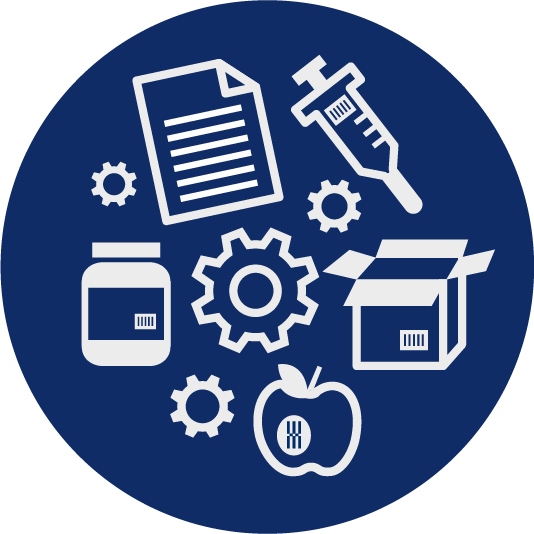Implementation details
This is what you need to consider in the implementation
How complex the transition from barcode to 2D code is depends largely on the individual circumstances, the objectives and the choice of product. For example, it is much easier to change the barcodes on a product where it is not integrated into the packaging layout but applied in the form of an adhesive label.
For a product like washing powder, where the EAN/UPC barcode has already been pre-printed on the empty packaging, the implementation is much more complicated. The only practical way would probably be to replace the barcode with GS1 DataMatrix codes that include a serial number in addition to the GS1 article number. In this way, the packaging can continue to be pre-printed, albeit with higher demands on the printing process and the filling process. In production, the packages are then filled as usual and the additional data is subsequently linked to the serial numbers in the ERP/PIM. However, this circumstance requires an exchange of master data at serial number level with the retail partners, who must then also be able to retrieve this data at all necessary points (such as the checkout environment).
Use our blueprints as a guide
In order to support you optimally during the implementation, we have developed blueprints for you. Please contact us if you need an additional blueprint.
| Blue Print |
is being or has been piloted at |
Complexity |
|
|---|---|---|---|
| Replace EAN/UPC barcode with GS1 DataMatrix |
|
low |
|
| Replace EAN/UPC barcode with GS1 DataMatrix for piece goods | Coop | medium | |
| Replace EAN/UPC barcode with GS1 DataMatrix for variable-quantity fresh products | GS1 Belgilux | medium | |
| Add EAN/UPC barcode with QR code and GS1 Digital Link | low | ||
| Supplement or replace EAN/UPC barcode or GS1 DataMatrix with QR Code and GS1 Digital Link | high | ||
| General serialization of products | high |
Blue Print: Replace EAN/UPC barcode with GS1 DataMatrix
Goals
- Reduction of the space required for the GS1 data carrier
- Use at the checkout (Point Of Sale) and in self-scanning
Steps
- Together with the supply chain partners involved in the process, determine which products are suitable for testing the transition.
- Define a schedule with your partners.
- Replace the EAN/UPC barcode with the GS1 DataMatrix code.
- Document your experience and the requirements that need to be met in your operation in order to start pilot projects with a trading partner.
Blue Print: Replace EAN/UPC barcode with GS1 DataMatrix for piece goods
Goals
- Add additional data such as MHD, batch number in the 2D code with the help of the GS1 Application Identifier (AI).
- Use at the checkout (Point Of Sale) and self-scanning
Steps
- Together with the supply chain partners involved in the process, determine which products are suitable for testing the conversion.
- Determine with your trading partner what additional data should be encoded in the 2D code in addition to the mandatory GS1 article number (GTIN).
- Consider the production process of the selected products and ensure that the additional data such as the BBD is available in the printing process.
- Contact your solution provider for the printing process and clarify whether the existing solution is capable of printing the necessary data in a GS1 DataMatrix.
- Check how you can cover the different requirements of your trading partners in your own production.
- Define a schedule with your partners.
- Replace the EAN/UPC barcode with the GS1 DataMatrix code.
- Document your experiences and the requirements that need to be met in your operation in order to start pilot projects with a trading partner.
Blue Print: Replace EAN/UPC barcode with GS1 DataMatrix for variable-quantity fresh products
Goals
- Use of the GS1 article number (GTIN) instead of the nationally unique GS1 article number (RCN) at best.
- Bar coding of product weight or individual price for quantity-variable fresh products
- Replacement of EAN/UPC barcodes by GS1 DataMatrix
- Using GS1 Application Identifier (AI) to add additional data such as MHD, batch number in 2D code
- Use at the checkout (Point Of Sale) and self-scanning
Steps
- Together with the supply chain partners involved in the process, determine which products are suitable for testing the conversion.
- Determine with your trading partner what additional data should be encoded in the 2D code in addition to the mandatory GS1 article number (GTIN).
- Consider the production process of the selected products and ensure that the additional data such as the BBD is available in the printing process.
- Contact your solution provider for the printing process and clarify whether the existing solution is capable of printing the necessary data in a GS1 DataMatrix.
- Check how you can cover the different requirements of your trading partners in your own production.
- Define a schedule with your partners.
- Replace the EAN/UPC barcode with the GS1 DataMatrix code.
- Document your experiences and the requirements that need to be met in your operation in order to start pilot projects with a trading partner.
Blue Print: Add QR Code and GS1 Digital Link to EAN/UPC Barcode
Goals
- Supplement EAN/UPC barcodes with QR codes that can be used for consumer engagement
- Add additional data such as MHD, batch number in the 2D code using the GS1 Digital Link standard
- Specify which web page is displayed if a consumer scans the QR code with their cell phone
Steps
- Together with the supply chain partners involved in the process, determine which products are suitable for testing the extension.
- Determine for your company what additional data should be encoded in the 2D code in addition to the mandatory GS1 article number (GTIN). This depends on the consumer needs you want to cover.
- Consider the production process of the selected products and make sure that the additional data is available in the printing process or can be pre-printed.
- Contact your solution provider for the printing process and clarify whether the existing solution is capable of printing the necessary data in a QR code. Take into account the space requirements.
- Add the QR code and GS1 Digital Link to the EAN/UPC barcode.
- Document your experience and the requirements that must be met in your operation in order to be able to start pilot projects with a trading partner.
Blue Print: supplement or replace EAN/UPC barcode or GS1 DataMatrix with QR code and GS1 Digital Link
Goals
- Add or replace EAN/UPC barcodes or GS1 DataMatrix with QR codes that can be used for consumer engagement
- Add additional data such as MHD, batch number in the 2D code using the GS1 Digital Link standard
- Determine which web page is displayed if a consumer scans the QR code with their cell phone
Steps
- Together with the supply chain partners involved in the process, determine which products are suitable for testing the extension.
- Determine for your company what additional data should be encoded in the 2D code in addition to the mandatory GS1 article number (GTIN). This depends on the consumer needs you want to cover and the requirements of your trading partners.
- Consider the production process of the selected products and ensure that the additional data is available or can be pre-printed in the printing process.
- Contact your solution provider for the printing process and clarify whether the existing solution is capable of printing the necessary data in a QR code.
- Replace the EAN/UPC barcode or GS1 DataMatrix with the QR code and GS1 Digital Link.
- Document your experience and the requirements that need to be met in your operation in order to start pilot projects with a trading partner.
Blue Print: General serialization of products
Goals
- Serialization of all products so that additional data can be exchanged with trading partners as consumer unit master data
- Most precise tracking and traceability
Steps
- Together with the supply chain partners involved in the process, determine which products are suitable for testing the extension.
- Determine for your company which and how the additional data should be exchanged as master data in addition to the serialized GS1 article number (SGTIN) encoded in the 2D code. This depends on the consumer needs you want to cover and the requirements of your trading partners.
- Consider the production process of the selected products and ensure that the additional data can be captured based on the serial numbers.
- Contact your solution provider for the printing process and master data exchange and clarify whether the existing solutions are capable of covering the necessary processes.
- Start serializing your products.
- Document your experiences and the requirements that must be met in your operation in order to start pilot projects with a trading partner.
Digital Link
The future of product labelling
GS1 Digital Link connects GS1 identification numbers to the web. With the global standard, different information is available via a single link and may be adapted at any time without having to renew the link.
What can GS1 Digital Link do?
GS1 Digital Link offers numerous possibilities:
The simplest use case is to generate a link for a specific GS1 article number (GTIN). GS1 Digital Link enables you to create the digital twin of your products.
Scan the following QR code with your mobile phone and you will be redirected to the GS1 General Specifications which are identified with the GTIN 7612345003993.
Encoded in the QR code is the link generated via the GS1 Digital Link Resolver, https://id.gs1.ch/01/07612345003993, which contains the GTIN of the GS1 General Specifications. GS1 Switzerland provides its members with a GS1 Digital Link Resolver so that they can exploit the full potential of the standard without any additional effort on their part.
Reasons for using a GS1 Digital Link
Why should GS1 members use the GS1 Digital Link Resolver from GS1 Switzerland?
There are numerous reasons. The following list is not meant to be exhaustive.
Trustworthiness and information sovereignty
The use of GS1's web address in the GS1 Digital Link shows that the distributor of this link also has the authority to establish such links. GS1 Switzerland only allows the owners of the GTINs to set up redirections.
Continuity
GTINs are rarely changed. A product usually carries its GTIN for the entire cycle of its existence. Accordingly, the GS1 Digital Links are long-lasting, as the GTIN is used for this purpose. If a link on your own website changes, the QR codes on the packaging do not have to be replaced.
Increase the reach
Many approaches, especially local ones, are not known to the wider world because nobody knows where and how to access these solutions. Global companies in particular need a kind of search engine to find out where which information is available. Linking these local solutions via the GS1 Digital Link Resolver network ensures that your data may be discovered.
Options instead of limitations
GS1 Digital Link enables all GS1 System users to take advantage of the possibilities opened up by the standard, and in particular by a GS1 resolver, in addition to existing implementations of the GS1 System. There are many different approaches to how and to what degree GS1 Digital Link may be used. Let the use cases inspire you.
Basics
The GS1 Digital Link standard essentially consists of two parts. The first part is the new language, which is technically called "syntax". This means that a language is created which works on the web but may also be used within the GS1 world. The second part is the so-called GS1 Digital Link Resolver, i.e. a practical solution offered by GS1, by our members themselves or by a third party. GS1 Digital Link apps may also be created using the GS1 barcodes that are already available. However, this requires that the app is capable of constructing a GS1 Digital Link from the data. Several different contents may be linked per GTIN. For example, links to product-related videos and product information websites.
With the help of the so-called "LinkTypes", specific links may be queried in the GS1 Resolver:
https://id.gs1.ch/01/07610032000010?linkType=gs1:relatedVideo
The different LinkTypes can be found here.
| [https://id.gs1.ch/ ] | = |
Address of the GS1 Resolver |
| [01] | = |
The type of GS1 identification number being requested.
"01" stands for the GTIN |
| [07610032000010] | = | The GTIN for which links are queried |
| [?linkType=gs1:relatedVideo] | = | the type of link that is being queried for |
A general query can be used to check what LinkTypes and which links have been registered for the queried GS1 identification number:
https://id.gs1.ch/01/07610032000010?linkType=all
The different LinkTypes can be found here.
| [https://id.gs1.ch/ ] | = |
Address of the GS1 Resolver |
| [01] | = |
The type of GS1 identification number being requested.
"01" stands for the GTIN |
| [07610032000010] | = | The GTIN for which links are queried |
| [?linkType=gs1:relatedVideo] | = | Query of all registered links for this GS1 identification number |
How does GS1 Digital Link work?
The user may search for data in the global resolver as well as in our local resolver with the help of the GTIN.
The technique used here is not new. Every query that is made on the web is redirected countless times before it reaches its destination. However, we do not notice the majority of these redirections, because these system-related redirections are hidden from our eyes. Most users, however, know about the possibility of shortening very long web addresses, for example, via corresponding services on the Internet. The GS1 Digital Resolver works according to this principle.
Due to the architecture, our users are free to use either the address of the global GS1 resolver in the GS1 Digital Link, that of the GS1 Switzerland resolver or even a member's resolver (company resolver).
Use Cases
Below you will find some use cases that we have already implemented. We will continuously expand this list.

Since August 2021, Gilgen has been labelling each of the components and assemblies with a QR code in which the GS1 Digital Link has been encoded. The GS1 Digital Link contains the GIAI (Global Individual Asset Identifier) and is used for maintenance and to record the history of the components. The approach ensures that the QR codes printed on the components and assemblies never have to be changed again, because if adjustments are made to the continuing links, these corrections can be made on the GS1 Digital Link Resolver itself.

Hot and al-dente at the touch of a button and six times faster than in the microwave. A sophisticated machine and high-quality ready meals make it possible. And thanks to a GS1 Digital Link, interactions between consumers and manufacturers are possible. The sophisticated device is called "Qeamer", a made-up word from Quick Steamer. The Qeamer is distributed by the company Cargogusto. The device directs highly concentrated steam into the food through fine nozzles to achieve the desired al-dente properties in less than a minute. The "Qeamer" gets the information it needs from the QR code. In addition to the information on the machine control (internal value), the Global Trade Item Number (GTIN) and the serialisation of the portion packaging in the form of a serial number are encoded in the QR code. In a second phase, the best-before date (BBD) is also mapped. The GS1 Digital Link leads the consumer directly to the product and to important product information such as nutritional values, ingredients and allergens. The same link provides the qeamer with the necessary details to prepare the dish correctly.

Our B2C solution, trustbox, already provides well over 40,000 product declarations for the Swiss market. Despite the intensive use and the central importance of trustbox in the Swiss market, trustbox is known abroad only in exceptional cases. Few know that every market participant may look for comprehensive product information on the publicly accessible trustbox website. GS1 Switzerland has registered the GTINs published in trustbox in the GS1 Digital Link Resolver. The trustbox customers now have the possibility, without any additional effort, to place a QR code on the products, which may be scanned by any app and leads the consumer directly to the corresponding publication in trustbox.
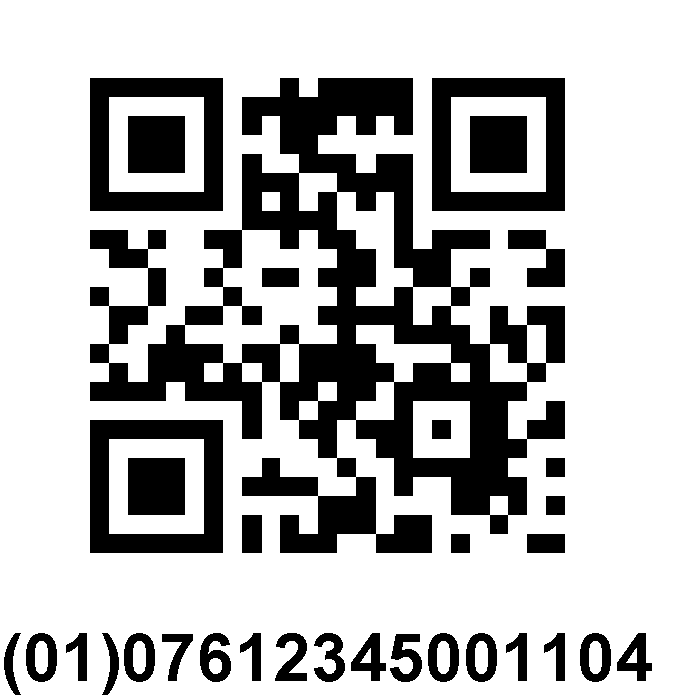
The Link https://id.gs1.ch/01/07612345001104 leads you to one of the example products that we have registered in trustbox.

Our member, Sonderegger Engineering AG, produces protective face masks in Switzerland and uses GS1 Digital Link so that consumers can easily and quickly access details about the face masks. In this use case, GS1 Digital Link provides not only general details about a product, but specific details about the exact packaging you just scanned.
The details you may access are not stored at GS1 Switzerland. The data comes directly from the source, as the company operates its own GS1 resolver. It is therefore not necessary to keep the details of the face masks up to date in different systems. GS1 Switzerland forwards all requests directly to the company resolver. On our part the effort is limited to registering new GS1 company prefixes (GCP) once in our GS1 Resolver.

Das Schweizer Startup PortaNet digitalisiert die beweglichen Bauteile Ihrer Immobilie. Die digitale Lösung MyPortaNet misst, steuert, dokumentiert und automatisiert den kompletten Lebenszyklus von Fenstern und Türen. Die Nutzerinnen und Nutzer erhalten statische Informationen zu den Bauteilen sowie dynamische Meldungen bezüglich Nutzung und Störungen via MyPortaNet Cloud Portal oder iOS/Android App. Damit wird proaktive Wartung Realität und Service-Verträge machen endlich Sinn. Industrie 4.0 für Fenster und Türen!
GS1 und buildingSMART International haben März 2019 gemeinsam die Initiative «Digitale Lieferkette in der Bauindustrie» ins Leben gerufen. Das Ziel der Initiative besteht darin, digitalisierte effiziente Arbeitsabläufe für alle Beteiligten der Wertschöpfungskette in der Bauindustrie zu entwickeln. Dies soll auf Basis von gemeinsam definierten Industriestandards und einer koordinierten Umsetzung dieser erfolgen. Oft sind dies bereits bestehende Techniken und Standards, wie beispielsweise die bewährten weltweit standardisierten Identifikationsnummern von GS1.
Der neue GS1 Digital Link verbindet die GS1 Identifikationsnummern nun auch direkt mit dem Web. So können verschiedene Informationen über einen spezifischen Link zur Verfügung gestellt und im Zielsystem jederzeit angepasst werden, ohne den Link an sich erneuern zu müssen. Neben der Standardisierung der Link Struktur besteht der grosse Vorteil insbesondere darin, dass die Verwaltung des Links respektive der hinterlegten Weiterleitung bei GS1 direkt durch den Nummern-Verantwortlichen erfolgt. Dies garantiert die Vertrauenswürdigkeit und Beständigkeit der Links heute und in Zukunft sowie die Unabhängigkeit vom eingesetzten Zielsystem.
PortaNet, GS1 Switzerland und iiotPro haben gemeinsam einen Proof-of-Concept einer mobilen MyPortaNet WebApp auf Basis des GS1 Digital Link aufgebaut. Mit Hilfe des sogenannten QID-TAG™ von PortaNet kann der Digital Link bei Bedarf auch mit einer Global Individual Asset Identifier (GIAI) als GS1 Identifikationsnummer umgesetzt werden. Damit kann MyPortaNet um eine entsprechende WebApp als Erweiterung der bestehenden Cloud Portal und iOS/Android App Lösung komplettiert werden. Dank der im Markt bewährten MyPortaNet Lösung zur Digitalisierung werden Türen und Fenster Ihrer Immobilie zu einem Vorzeigebeispiel der Initiative «Digitale Lieferkette in der Bauindustrie»!
Hier, in dem folgenden GS1 Digital Link https://id.gs1.ch/8004/7612345CH1QID0200004550 wird die interne Identifikationsnummer des obigen QID-TAG™ als Teil der GIAI der GS1 Eingangstüre Büro Bereich (7612345CH1QID0200004550) eingebunden. Ausserdem ist die QID-TAG™ Identifikationsnummer (CH1QID0200004550) mit dem CycleCounter® verknüpft, welcher die dynamischen Status-Meldungen bezüglich der Nutzung der Türe ermöglicht.
Offer by GS1 Switzerland
Members of GS1 Switzerland who use the GS1 System may contact system support directly to discuss the possibilities. The use of the GS1 Digital Link Resolver is included in the membership fees. Please note that our basic offer gives you the possibility to manage registrations in the GS1 Resolver via the office during the usual business hours of GS1 Switzerland. As always, adjustments will be carried out as quickly as possible and within a maximum of three working days.
Offer by our service provider EVRYTHNG
EVRYTHNG has been operating a global solution for many years, which not only manages product data at the GTIN level, but also completely serialised products (internet of things). Parties who are interested in using GS1 Digital Link, but also have additional needs such as direct access to registrations or would like to have products serialised automatically, may contact EVRYTHNG.
Contact details EVRYTHNG: www.evrythng.com/GS1

LEI
Apply for or renew your LEI number
The Legal Entity Identifier (LEI) number is a unique 20-digit alphanumeric number. The LEI number is used to identify companies and other legal entities operating in the securities market.
In accordance with recording and reporting obligations under Swiss law (see art. 39 of the Financial Market Infrastructure Act and the transitional provisions of the corresponding ordinance) and under European law (MiFID II / MiFIR and EMIR), numerous businesses such as banks, credit institutions, investment funds, insurance companies, securities services providers and foundations must have a Legal Entity Identifier (LEI).
As of 1 January 2022, LEIs for Swiss companies will be issued directly by GS1 Germany. If you have any questions, please contact GS1 Germany.
Contact
GS1 Germany
T: +49 221 94714-600
support@lei.direct
Standard article number (SAN)
Standard article number replaced with 2D data carriers
The SAN (Standard Article Number/Standard Number) is a specific four-digit identification for variable-quantity fresh produce. However, GS1 recommends the use of the globally unique GTIN together with a 2D data carrier instead of the SAN.
DThe most common variant is "standard article number + price"
GS1 Switzerland maintains a standard number catalogue for variable-quantity consumer units for
- meat and fish products
- dairy products
- fruit and vegetables
The standard article numbers are available to you as an Excel table and as a PDF. You can thus check at any time whether a 4-digit identification already exists for your variable-quantity article.
Note
Since 2018 no new standard numbers have been assigned.
GS1 recommends the use of the globally unique GTIN instead of the SAN. Unfortunately, not all market participants are yet able to process the required alternative symbologies - GS1 DataBar and GS1 DataMatrix.
If you intend to use one of the two variants, you should definitely contact GS1 Switzerland in advance. We will be happy to help you find the best solution for you.
GTIN Registry
GTIN registration made easy
Create and manage your GTINs and EAN-13 barcodes easily now with the GTIN Registry, the free offer for our members.
How it works
Log in
Log in to the programme and create a new GTIN. The next free number is automatically displayed and the check digit is immediately calculated correctly.
Describe
Describe the product completely and correctly and upload a picture.
Create
Create a print-quality barcode with one click, download it and print it on the packaging.
Done
The product is now uniquely identified worldwide and ready for stationary trade and for sale at online marketplaces.
Frequently asked questions
What is a GTIN?
You need the GTIN, the "Global Trade Item Number", to create a barcode for the labelling of your products.
What is the GTIN Registry?
The GTIN Registry is an online tool. This tool allows you to create GS1 article numbers (GTINs) from the company prefix (GCP) and then download EAN-13 barcodes. In addition, you can enter product master data in structured form.
Who can use the GTIN Registry?
The GTIN Registry is a service for members of GS1 Switzerland who have licensed one or more company prefixes (GCP).
How do I get GTINs?
GTINs can be obtained by going to the ordering website: https://www.gs1.ch/en/barcodes-standards/barcodes
What are the benefits of using the GTIN Registry?
Thanks to the GTIN Registry:
- you always know which GTIN you have used for which product
- the next free GTIN is assigned directly to a new product
- there's no need to calculate the check digit
- you get the right barcode in the best quality and according to the requirements of the trade concerning valid and verified identification
Kann ich für meine MitarbeiterInnen einen Zugang einrichten?
he GTIN Registry is multi-user capable. This allows you to delegate GTIN management to your employees.
Make sure that your deputy has access to the GTIN Registry.
To do this, they must first create (register) an online account: To register.
Then let us know via the contact form for which persons (name, e-mail address) we may activate the access.
I have lost my password. What can I do?
Please use the "Forgotten password" function on www.gtinregistry.ch, which you will find directly under the login area. To do so, click on "Login" and on "Forgotten password" and follow the instructions step by step.





